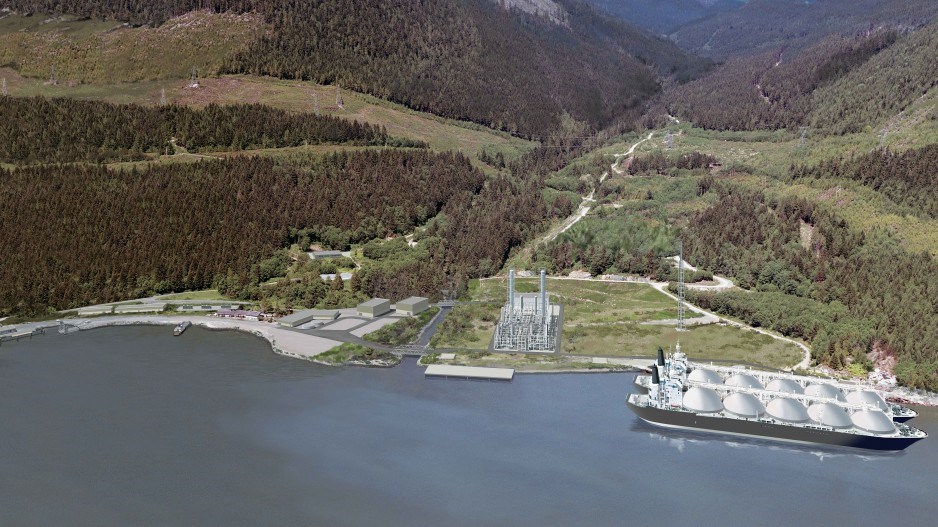Compared with some other liquefied natural gas (LNG) plants proposed for B.C., Pacific Oil and Gas’ Woodfibre LNG project in Squamish is small.
But at a capital cost of $1.7 billion, even a small LNG plant like Woodfibre is a sizable investment and generator of jobs and taxes – something on the scale of a new pulp mill or three mines the size of the new Red Chris mine.
The project would generate roughly $2 million in taxes annually for the District of Squamish and create about 650 jobs per year over two years during its construction and approximately 100 permanent full-time jobs with an average wage of between $70,000 and $75,000.
Compared with a pulp mill or mine, the environmental impact of the Woodfibre LNG project is relatively small. For one thing, it will use electricity to power the cooling process – unlike most other proposals, which would burn natural gas.
And unlike Petronas’ Pacific NorthWest LNG project – a greenfield site located in a sensitive estuary – the Woodfibre LNG project would be built on a brownfield site – a former pulp mill shut down in 2006.
Its construction would result in a multimillion-dollar environmental cleanup – already underway – that includes closing old landfills and removing 3,000 creosote pilings from an old dock.
So why is Squamish essentially saying “no thanks” to the project?
“Council, at this point, has said it’s not supportable,” said Squamish Mayor Patricia Heintzman. “We’re saying it doesn’t meet the litmus test at this point.”
When the Woodfibre pulp mill shut down in 2006, it blew a $1.8 million hole in Squamish’s tax base. It has since been made up by shifting the tax burden to residents and businesses.
While it’s estimated the Woodfibre LNG project would more than replace the taxes it lost from the closed pulp mill – at least $2 million annually – Howe’s Sound’s legacy of pollution from Britannia mine, pulp mills and chemical plants makes new heavy industry a hard sell in Squamish.
But Squamish Coun. Doug Race, who supports the project, also believes Woodfibre LNG has become a fossil-fuel-industry lightning rod.
“I don’t think a lot of the pushback comes so much from the view of this particular project as it is against the industry as a whole,” Race said. “It’s fracking, it’s climate change, it’s fossil fuel issues, greenhouse gas emissions. I think those people just have issues that they will just never reconcile with this project.”
From an investment standpoint, the Woodfibre LNG project has a lot going for it. The company developing it, Pacific Oil and Gas, owned by Indonesian billionaire Sukanto Tanoto, owns gas-fired thermal power plants and 35% of an LNG marine terminal in China. It already has signed a memorandum of understanding with a utility in Guangzhou for half the gas it would produce, said Byng Giraud, Woodfibre’s vice-president of corporate affairs.
The site has three advantages. Aside from already being zoned for heavy industry, it has access to a 500-kilovolt transmission line, which means it can use hydroelectricity for its liquefaction process.
That dramatically reduces the greenhouse gases (GHGs) it would produce, compared with other LNG plants.
“Its GHGs have been reduced by 80%, and that makes it one of the greenest LNG facilities,” Giraud said.
In addition, the company doesn’t need to build a new pipeline. FortisBC already supplies natural gas to the area, although supplying the LNG plant will require a new 47-kilometre twin line to be built along an existing corridor from Port Coquitlam to Squamish.
Whereas Petronas needs several First Nations on board for its plant in Prince Rupert, Woodfibre LNG has only one First Nation to negotiate with.
The Squamish Nation has not yet taken a stand on the project but has undertaken its own environmental impact study, citing distrust of the Environmental Assessment Office (EAO) process.
The Squamish Nation’s study weighs both the risks and benefits of the project, a spokesman said. The Squamish Nation council will vote in the coming weeks on whether to support or oppose the Woodfibre LNG project.
The study will be included in the provincial EAO process. A decision from the B.C. EAO is expected in July.
Woodfibre LNG would produce 2.1 million tonnes of liquefied natural gas per year – about one-ninth what the Pacific NorthWest LNG plant would produce. That would require about one LNG tanker every 10 days to move up Howe Sound, Giraud said.
The biggest environmental concern with Woodfibre LNG may be the use of Howe Sound as a heat sink. During the process of chilling the gas to -160 C to liquefy it, a tremendous amount of heat is extracted.
The plant would vent that heat by circulating 17,000 cubic metres of sea water per hour. The water would re-enter Howe Sound roughly 10 C hotter than when it entered the plant.
Lynn Mueller, president of International Wastewater Systems – which specializes in capturing heat from waste water – said that’s a lot of heat to be pouring into Howe Sound.
Although the temperature of the water that the plant would release would be about 20 C lower than that of the water the City of Vancouver releases from its sewage treatment plants, Mueller said the volume is 20 times higher.
“It’s like adding three more cities the size of Vancouver dumping heat into the ocean,” Mueller said.
Race said Squamish has had staff analyze the proposal and does not believe discharging that much water at higher temperatures will harm the marine environment.
“We’ve had people come from the Vancouver Aquarium, for example, who said squirting that amount of water back into Howe Sound is not significant,” Race said.




